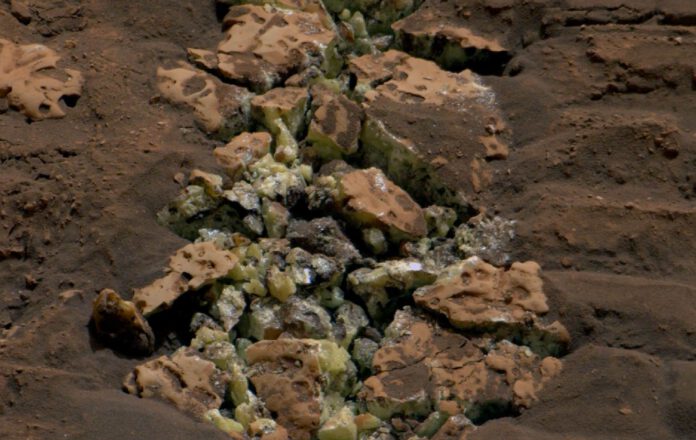
Mars Rover Curiosity Uncovers Unprecedented Sulfur Crystals
Scientists were astonished when a rock that Mars rover Curiosity drove over cracked open and revealed something never before seen on the Red Planet: yellow sulfur crystals.
Since October 2023, Curiosity has been exploring an area on Mars rich in sulfates, a type of salt containing sulfur formed when water evaporates. However, researchers were very surprised when they took a closer look at a rock Curiosity had accidentally broken. Curiosity had unexpectedly found rocks composed of pure sulfur – a first on Mars.
Yellow Sulfur Crystals
Below is an image of the yellow sulfur crystals. Where previous discoveries involved sulfur-containing minerals – a mix of sulfur and other materials – the rock shown below consists of elemental, or pure, sulfur. It remains unclear what relationship, if any, this pure sulfur has with the other sulfur-containing minerals in the area.
What is Sulfur?
Curiosity does not need to hold its nose near these yellow sulfur crystals. Although sulfur is often associated with the smell of rotten eggs (due to hydrogen sulfide gas), pure sulfur is odorless. The remarkable thing is that it forms under a limited set of conditions which scientists had not previously linked to the history of the site. Moreover, Curiosity found a lot of it: it was scattered across a field of bright rocks similar to the one the rover drove over.
Like Finding an Oasis
Mission members are ecstatic. “Discovering a field of pure sulfur rocks is like finding an oasis in the desert,” explains mission member Ashwin Vasavada. “It shouldn’t really be there, so now we need to figure out how it came to be. Finding such strange and unexpected things makes planetary exploration so exciting.”
Unexpected Discoveries
The discovery of yellow sulfur crystals can be added to the already impressive list of noteworthy finds made by Curiosity. While exploring the Gediz Vallis channel, a trench winding along part of the five-kilometer-high Mount Sharp, which the rover has been climbing since 2014, it has encountered many surprises. Each layer of the mountain represents a different period in Mars’ history. Curiosity’s mission is to investigate where and when the ancient surface of the planet may have provided the nutrients needed for microbial life, should life ever have existed on Mars.
Exploring Gediz Vallis Channel
The Gediz Vallis channel was already spotted from space years before Curiosity’s launch and is one of the main reasons why the scientific team wanted to explore this part of Mars. Scientists believe the channel was formed by flows of liquid water and debris, leaving behind a ridge of cobbles and sediment extending about three kilometers along the mountainside below the channel. The goal is to better understand how this landscape changed billions of years ago. While recent discoveries have been useful, much remains to be learned from this impressive landscape.
A Tumultuous Past
Since Curiosity arrived at the channel this year, scientists have been investigating whether ancient floods or landslides are responsible for the large debris piles rising from the bottom of the channel. The most recent data from Curiosity suggests that both factors played a role: some piles were likely formed by intense water and debris flows, while others may result from more localized landslides. These conclusions are based on the rocks found in the debris piles: rocks carried by water flows are often rounded like river stones, while some debris piles are full of more angular rocks that may have been deposited by dry avalanches.
The Role of Water
Ultimately, water spread through all the material deposited here. Chemical reactions caused by the water created white ‘halo’ shapes in some rocks. Erosion by wind and sand made these halo shapes visible over time. “This was not a quiet period on Mars,” says researcher Becky Williams. “We see various flows through the channel, including powerful floods and debris-laden streams.” In short, these findings suggest that Mars was a much more active planet in the past than previously thought, with periods of violent floods and landslides shaping the landscape.
The Mammoth Lakes Rock
All this water-related evidence reveals a more complex story than the team initially expected. They were therefore excited to acquire a rock sample from the channel to discover more. Although the sulfur rocks were too small and brittle for sampling with the drill, a large rock nicknamed ‘Mammoth Lakes’ was found nearby. Mission members had to find a suitable section of the rock for safe drilling and a suitable spot on the loose, sloping surface to park. After Curiosity drilled its 41st hole with the powerful drill at the end of its two-meter-long robotic arm, the powdery rock was collected in the rover’s instruments for further analysis. This allows scientists to determine what materials the rock is composed of.
Overall, Curiosity’s discoveries in the Gediz Vallis channel have significantly deepened the understanding of Mars’ geological history. And each new find brings scientists closer to unraveling the question of whether Mars ever had the conditions necessary for microbial life. Curiosity has now left Mammoth Lakes and is on its way to discover what other surprises the channel has in store.











